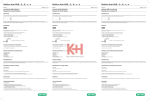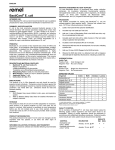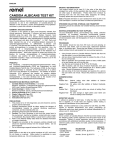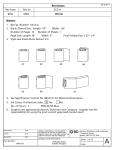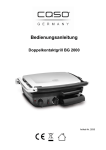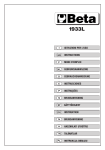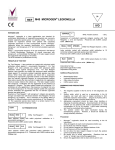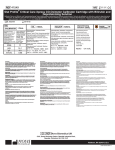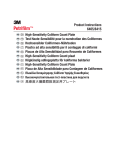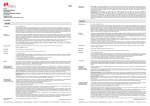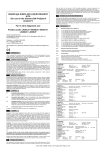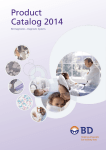Download B Difco™ E. Coli Antisera
Transcript
B Difco™ E. Coli Antisera U English: pages 1–4 Italiano: pagine 11 –14 Français : pages 5 –8 Español: páginas 15 –18 Deutsch: Seiten 8 –11 8085880 (02) 2014-12 Contact your local BD representative for instructions. / Свържете се с местния представител на BD за инструкзии. / Pokyny vám poskytne místní zástupce společnosti BD. / Kontakt den lokale BD repræsentant for at få instruktioner. / Επικοινωνήστε με τον τοπικό αντιπρόσωπο της BD για οδηγίες. / Kasutusjuhiste suhtes kontakteeruge oma kohaliku BD esindajaga. / Ota yhteys lähimpään BD:n edustajaan ohjeiden saamiseksi. / Kontaktiraj lokalnog predstavnika BD za upute. / A használati utasítást kérje a BD helyi képviseletétől. / Нұсқаулар үшін жергілікті BD өкілімен хабарласыңыз. / Lai saņemtu norādījumus, sazinieties ar vietējo BD pārstāvi. / Naudojimo instrukcijų teiraukitės vietos BD įgaliotojo atstovo. / Neem contact op met uw plaatselijke BD-vertegenwoordiger voor instructies. / Kontakt din lokale BD-representant for mer informasjon. / Aby uzyskać instrukcje użytkowania, skontaktuj się z lokalnym przedstawicielstwem BD. / Contacte o representante local da BD para instruções. / Pentru instrucţiuni, contactaţi reprezentantul local BD. / Для получения указаний обратитесь к местному представителю компании BD. / Inštrukcie získate u miestneho zástupcu spoločnosti BD. / Obratite se svom lokalnom predstavniku kompanije BD za uputstva. / Kontakta närmaste BD-representant för anvisningar. / Talimatlar için yerel BD temsilcinizle temasa geçin. / За інструкціями зверніться до місцевого представника компанії BD. INTENDED USE Difco™ E. Coli O Antiserum O157 and Difco E. Coli H Antiserum H7 are used for identifying Escherichia coli O157:H7. SUMMARY AND EXPLANATION E. coli O157:H7 is a foodborne pathogen that can cause potentially fatal entericrelated disease in humans.1-7 This disease is characterized by sudden onset of severe cramps and abdominal pain, followed by a watery stool that may become markedly bloody. A series of 107 outbreaks involving 387 persons was traced to imported Camembert cheese in the United States in 1971.8 E. coli O157:H7 was recognized as a cause of hemorrhagic colitis in 19824 and hemolytic uremic syndrome in 1983.9 The 1982 outbreak was derived from ingested hamburgers.4,10 The incidence of disease caused by this organism has increased significantly over the past decade.3,11 The largest outbreak of E. coli O157:H7 disease occurred during January 1993, in Washington State where more than 600 patients with hemorrhagic colitis were confirmed.1 The source of the outbreak was identified as undercooked hamburger at multiple outlets of the same fast food restaurant chain. E. coli O157:H7 is an enteric pathogen that requires only a low inoculum to cause disease. Transmission is usually via high-volume food items whose preparation is not always under stringent control and is served to a target audience (children and the elderly are most at risk for complications of the illness). The organism has been isolated from several foods, including undercooked hamburger, drinking water, new potatoes, turkey roll, raw milk and apple cider. Serotyping of the enterohemorrhagic E. coli is useful in the epidemiological documentation of the spread of a particular strain in a foodborne outbreak.11 PRINCIPLES OF THE PROCEDURE Difco E. Coli O Antiserum O157 is used in the tube agglutination technique for O antigen titration. Difco E. Coli H Antiserum H7 is used in the tube agglutination technique for detecting H antigens. These antisera are used to confirm the presence of E. coli O157:H7 after selective isolation. The serological technique is based on the reaction of a specific antiserum with its homologous antigen. While the specificity of serological methods is not absolute, serotyping of E. coli, along with biochemical characteristics, can provide an accurate identification of the etiological agent. REAGENTS Difco E. Coli O Antiserum O157 and Difco E. Coli H Antiserum H7 are lyophilized, polyclonal rabbit antisera containing approximately 0.2% sodium azide as a preservative. Warnings and Precautions For in vitro Diagnostic Use. This Product Contains Dry Natural Rubber. Observe aseptic techniques and established precautions against microbiological hazards throughout all procedures. After use, specimens, containers, slides, tubes and other contaminated material must be sterilized by autoclaving. Directions for use should be followed carefully. WARNING: This product contains sodium azide. Sodium azide is toxic by inhalation, by skin contact, and if swallowed. Contact with acid liberates very toxic gas. After contact with skin, wash immediately with plenty of water. Sodium azide may react with lead and copper plumbing to form highly explosive metal azides. On disposal, flush with a large volume of water to prevent azide build-up. Warning H302 Harmful if swallowed. P264 Wash thoroughly after handling. P301 + P312 IF SWALLOWED: Call a POISON CENTER/doctor if you feel unwell. P501 Dispose of contents/container in accordance with local/regional/national/international regulations. Storage: Store lyophilized and rehydrated Difco™ E. Coli Antisera at 2-8 °C.z Prolonged exposure of reagents to temperatures other than those specified is detrimental to the products. The expiration date applies to the product in its intact container when stored as directed. Product Deterioration: Do not use if the product is caked, discolored or shows other signs of deterioration. SPECIMEN COLLECTION AND PREPARATION For isolation of E. coli O157 from bloody stool samples, use MacConkey Sorbitol Agar. For isolation of this organism from food, use SMAC-CT (Sorbitol MacConkey Agar w/Cefixime and Tellurite).12 However, high levels of contaminating coliform organisms will mask the O157 strains.13 Procedures for serological confirmation by Difco E. Coli Antisera require a pure culture of the test organism isolated on Veal Infusion Agar or other enriched solid medium. PROCEDURES Materials Provided: Difco E. Coli O Antiserum O157 and Difco E. Coli H Antiserum H7. Materials Required But Not Provided: Veal Infusion Agar, Motility GI Medium, Water bath, 50 ± 2 °C, Formalin, McFarland Barium Sulfate Standard No. 3, Culture tubes 12 x 75 mm and rack, Serological pipettes, 1 mL, Sterile 0.85% NaCl solution. Reagent Preparation Equilibrate all materials to room temperature before performing the tests. Ensure that all glassware and pipettes are clean and free of residues such as detergents. Difco E. Coli antisera: To rehydrate, add 3 mL sterile 0.85% NaCl solution to each vial. Rotate gently to dissolve contents completely. The rehydrated antisera are considered a 1:2 working dilution. USER QUALITY CONTROL At the time of use, test both positive and negative control cultures to check performance of the antiserum, techniques and methodology. Quality control requirements must be performed in accordance with applicable local, state and/or federal regulations or accreditation requirements and your laboratory’s standard Quality Control procedures. It is recommended that the user refer to pertinent CLSI guidance and CLIA regulations for appropriate Quality Control practices. Test Procedure Tube Test for O Antigen Titration 1.Prepare pure cultures of the test organism by plating onto Veal Infusion Agar and incubating at 35 ± 2 °C for 16-18 h. 2.Suspend the test isolate growth obtained from solid agar medium in 0.85% NaCl solution to give a homogeneous suspension. 3. Heat the organism suspension in a boiling water bath for 30-60 min. The culture should be homogeneous. Precipitation indicates a rough culture and the suspension should be discarded. 4.Allow the suspension to cool; dilute with 0.85% NaCl solution to a density approximating that of a McFarland Barium Sulfate Standard No. 3. 5.Add formalin to a final concentration of 0.5% by volume. 6.In a rack, prepare a row of 8 test tubes for each organism suspension to be tested. 7. Dispense 0.9 mL 0.85% NaCl solution to the first tube in each row and 0.5 mL to the remaining tubes. 8.Prepare serial dilutions using the rehydrated Difco E. Coli O Antiserum O157. Using a 1 mL serological pipette, add 0.1 mL of antiserum to tube 1 in each row and mix thoroughly. Transfer 0.5 mL from tube 1 to tube 2 and mix thoroughly. 2 In a like manner, continue transferring 0.5 mL through tube 7, discarding 0.5 mL from tube 7 after mixing. Tube 8 is a negative control tube containing only 0.85% NaCl solution. 9.Add 0.5 mL of the test organism suspension to each of the 8 tubes. Upon addition of the test organism suspension, final dilutions will be 1:40 through 1:2,560 for tubes 1 through 7, respectively. 10.Shake the rack to mix. Incubate in a 50 ± 2 °C water bath for 18-24 h. 11.Read for agglutination. Tube Test for H Antigen Detection 1.Prepare an actively motile culture of the suspect E. coli culture by several successive transfers in Motility GI Medium. At least 2-3 passages through Motility GI Medium are necessary before attempting to establish the presence and identity of H antigens. Fresh isolates of E. coli generally have poorly developed flagella. 2.Inoculate a loopful of the Motility GI Medium culture into a tube of Veal Infusion Broth. Incubate 6-8 h at 35 ± 2 °C or overnight, if necessary. 3. Inactivate the culture by adding formalin to a final concentration of 0.3% (0.3 parts formaldehyde per 100 parts of the Veal Infusion Broth culture). If necessary, adjust the density of the suspension with formalized saline to approximate a McFarland Barium Sulfate Standard No. 3. This broth culture will be used as the test antigen in step 6. 4.Prepare a 1:500 dilution of Difco E. Coli H Antiserum H7 by adding 0.2 mL of the rehydrated 1:2 working solution to 49.8 mL of 0.85% NaCl solution. 5. Pipette 0.5 mL of the diluted antiserum into a test tube. 6.Add 0.5 mL of the test organism broth culture from step 3 and mix well. The resulting antiserum dilution will be 1:1,000. 7. Incubate in a 50 ± 2 °C water bath for 1 h. 8. Read for agglutination. RESULTS Observe test result with indirect lighting against a dark background. Record agglutination as follows: 4+100% agglutination of cells; supernatant fluid is clear to slightly hazy. 3+75% agglutination of cells; supernatant fluid is slightly cloudy. 2+50% agglutination of cells; supernatant fluid is moderately cloudy. 1+ 25% agglutination of cells; supernatant fluid cloudy. ± Less than 25% agglutination of cells. – No agglutination Difco E. Coli O Antiserum O157 – Tubes showing a 2+ or greater agglutination at 1:320 or greater are considered positive. Difco E. Coli H Antiserum H7 – Tubes showing 2+ or greater agglutination are considered positive. LIMITATIONS OF THE PROCEDURE 1.Serological techniques employing E. Coli Antisera serve as corroborative evidence for the identification of E. coli O157:H7. Final identification cannot be made without consideration of morphological, serological and biochemical characterization. 2. Excessive heat from external sources (hot bacteriological loop, burner flame, light source, etc.) may prevent making a smooth suspension of the microorganism or cause evaporation or precipitation of the test mixture. Falsepositive reactions may occur. 3. Rough culture isolates occur and will agglutinate spontaneously, causing agglutination in a normal serum (autoagglutination). Smooth colonies must be selected and tested in serological procedures. 4.Prolonged exposure of reagents to temperatures other than those specified is detrimental to the products. 5.It is important in this test to use the recommended time and temperature of incubation. In addition, care should be taken to make certain that the water bath is in a location free of mechanical vibration. 6.Discard Difco E. Coli Antisera that are cloudy or have a precipitate after rehydration or storage. PERFORMANCE CHARACTERISTICS14 The performance of the Difco E. Coli O Antiserum O157, manufactured by Difco Laboratories, was compared to a commercially available latex test in a study published by Chapman.14 Pure cultures of 91 bacterial isolates were tested.14,15 3 The table below lists the results obtained. All E. coli previously confirmed as O157 were positive by the Difco tube agglutination method. All other organisms tested were negative by the Difco tube agglutination method. No. of Samples Strain Difco™ E. Coli Antiserum O157 Tube Agglutination Test Positives Commercially Available Latex Test Positives 30 E. coli O157 30 30 30 E. coli non-O157 0 0 30 Non-sorbitol fermenting organisms 0 0 1 Escherichia hermanii 0 0 AVAILABILITY Cat. No. 229701 Description BD Difco™ E. Coli O Antiserum O157, 3 mL 221591 BD Difco™ E. Coli H Antiserum H7, 3 mL REFERENCES 1.Centers for Disease Control. 1993. Emerging infectious diseases. Morb. Mort. Wkly. 42:257 – 260. 2. Glass, K.A., J.M. Leffelholtz, J.P. Ford, and M.P. Doyle. 1992. Fate of Escherichia coli 0157:H7 as affected by pH or sodium chloride and in fermented, dry sausage. Appl. Environ. Microbiol. 58:2513 – 2516. 3.Padhye, N.V., and M.P. Doyle. 1992. Escherichia coli 0157:H7 epidemiology, pathogenesis, and methods for detection in food. J. Food Prot. 55:555 – 565. 4.Riley, L.W., R.S. Remis, and S.D. Helgerson, et al. 1983. Hemorrhagic colitis associated with a rare Escherichia coli serotype. N. Engl. J. Med. 308:681 – 685. 5.Samadpour, M., L. Grimm, B. Desai, D. Alfi, J.E. Ongerth, and P.I. Tarr. 1993. Molecular epidemiology of Escherichia coli 0157:H7 strains using bacteriophage A–restriction fragment length polymorphism analysis: application to a multistate foodborne outbreak and a day care center cluster. J. Clin. Microbiol. 31:3179 – 3183. 6.Tarr, P.I. 1994. Review of 1993 Escherichia coli 0157: H7 outbreak: western United States. Dairy, Food, and Environmental Sanitation. 14:372 – 373. 7.Gray, L.D. 1995. Escherichia, Salmonella, Shigella, and Yersinia, p. 450 – 455. In P.R. Murray, E.J. Baron, M.A. Pfaller, F.C. Tenover, and R.H. Yolken (ed.), Manual of clinical microbiology, 6th ed. American Society for Microbiology, Washington, D.C. 8.Marrier, R., J.G. Wells, R.C. Swanson, W. Callahan, and I.J. Mehlman. 1973. An outbreak of enteropathogenic E. coli foodborne disease traced to imported French cheese. Lancet 2:1376 – 1378. 9.Flowers, R.S., W. Andrews, C.W. Donnelly, and E. Koenig. 1993. Pathogens in milk and milk products, p. 168 – 176. In R. T. Marshall (ed.), Standard methods for the examination of dairy products, 16th ed. American Public Health Association. Washington, D.C. 10. Morbidity and Mortality Weekly Reports. November, 1982. 11.Lior, H. 1994. Escherichia coli O157: H7 and verotoxigenic Escherichia coli (VTEC). Dairy, Food, and Environ. Sanit. 14:378 – 382. 12.Association of Official Analytical Chemists. 2001. FDA bacteriological analytical manual online. <http://www.cfsan.fda.gov/~ebam/bam-mm.html>. 13.Meng, J.P. Feng and M.P. Doyle. 2001. Pathogenic E. coli, p. 331 – 341. In P. Downes and K. Ito (ed.), Compendium of methods for the microbiological examination of foods, 4th ed. American Public Health Association, Washington, D.C. 14.Chapman, P.A. 1989. Evaluation of commercial latex slide test for identifying Escherichia coli O157. J. Clin. Pathol. 43:1109 – 1110. 15. Chapman, P.A., D.J. Wright and P. Norman. 1989. Verotoxin-producing Escherichia coli infections in Sheffield: cattle as a possible source. Epidem. Infect. 102:439 – 45. Technical information: In the United States, contact BD Technical Service and Support at 800-638-8663 or www.bd.com/ds. 4 B Difco E. Coli Antisera Français APPLICATION Le Difco E. Coli O Antiserum O157 et le Difco E. Coli H Antiserum servent à l’identification d’Escherichia coli O157:H7. RESUME ET EXPLICATION E. coli O157:H7 est un pathogène d’origine alimentaire responsable d’infections entériques potentiellement mortelles chez l’homme.1-7 Ces infections se caractérisent par l’apparition soudaine de crampes et de douleurs abdominales sévères, suivies d’une diarrhée aqueuse pouvant devenir sanglante. En 1971, une série de 107 contaminations ayant touché 387 personnes aux Etats-Unis a été reliée à des importations de camembert.8 E. coli O157:H7 a été identifié comme l’agent causal de la colite hémorragique en 19824 et du syndrome urémique hémolytique en 1983.9 L’épidémie de 1982 a été reliée à la consommation de hamburgers.4,10 L’incidence des maladies provoquées par ce microorganisme s’est accrue de façon significative au cours de la dernière décennie.3,11 L’épidémie la plus importante de contamination par E. coli O157:H7 s’est produite en janvier 1993, dans l’Etat de Washington (Etats-Unis), où plus de 600 patients ont été diagnostiqués avec une colite hémorragique.1 La contamination a été reliée à des hamburgers insuffisamment cuits, fabriqués dans plusieurs établissements d’une même chaîne de restauration rapide. E. coli O157:H7 est un pathogène entérique qui ne nécessite qu’un faible inoculum pour provoquer la maladie. La transmission s’effectue habituellement par l’intermédiaire de préparations alimentaires de masse, qui ne sont pas toujours soumises à des règles de contrôles strictes et servies à un public cible (les enfants et les personnes âgées étant les plus exposées aux risques de complications de la maladie). Le microorganisme a été isolé à partir de plusieurs aliments, notamment des hamburgers insuffisamment cuits, l’eau de boisson, les pommes de terre nouvelles, le rôti de dinde, le lait cru et le cidre. Le sérotypage des E. coli entérohémorragiques est utile pour documenter l’épidémiologie de la propagation d’une souche donnée dans une épidémie d’origine alimentaire.11 PRINCIPES DE LA METHODE Le Difco E. Coli O Antiserum O157 s’utilise dans la technique d’agglutination en tube pour le titrage de l’antigène O. Le Difco E. Coli H Antiserum H7 s’utilise dans la technique d’agglutination en tube pour le titrage des antigènes H. Ces antisérums servent à confirmer la présence d’E. coli O157:H7 après isolement sélectif. La technique sérologique est basée sur la réaction d’un antisérum spécifique avec son antigène homologue. Alors que la spécificité des méthodes sérologiques n’est pas totale, le sérotypage d’E. coli, complété par des tests biochimiques, peut fournir une identification exacte de l’agent causal. REACTIFS Le Difco E. Coli O Antiserum O157 et le Difco E. Coli H Antiserum H7 sont des antisérums polyclonaux de lapin lyophilisés contenant environ 0,2 % d’azide de sodium (agent conservateur). Avertissements et précautions Réservé au diagnostic in vitro. Ce produit contient du caoutchouc naturel sec. Toujours utiliser des techniques aseptiques et prendre les précautions en vigueur contre les dangers microbiologiques. Après utilisation, stériliser à l’autoclave les échantillons, les récipients, les lames, les tubes et les autres matériels contaminés. Respecter scrupuleusement le mode d’emploi. AVERTISSEMENT : Ce produit contient de l’azide de sodium, qui est toxique par inhalation, contact avec la peau ou ingestion. Au contact d’un acide, un gaz très toxique est dégagé. Après tout contact avec la peau, laver immédiatement à grande eau. L’azide de sodium peut réagir au contact du plomb ou du cuivre des canalisations et former des azides métalliques très explosifs. Lors de l’élimination, faire couler un volume d’eau important pour éviter l’accumulation d’azides. Attention H302 Nocif en cas d’ingestion. P264 Se laver soigneusement après manipulation. P301 + P312 EN CAS D’INGESTION: Appeler un CENTRE ANTIPOISON ou un médecin en cas de malaise. P501 Éliminer le contenu/récipient conformément aux règlements locaux/régionaux/nationaux/internationaux. 5 Conservation : Conserver les Difco E. Coli Antisera lyophilisés et reconstitués entre 2 et 8 °C. L’exposition prolongée des réactifs à des températures autres que les températures spécifiées a un effet adverse sur ceux-ci. La date de péremption s’applique au produit contenu dans son emballage intact et conservé conformément aux instructions. Détérioration du produit : Ne pas utiliser si le produit présente un aspect agglutiné, décoloré ou d’autres signes de détérioration. PRELEVEMENT ET PREPARATION DES ECHANTILLONS Sert à l’isolement d’E. coli O157 à partir d’échantillons fécaux sanglants sur gélose au sorbitol de MacConkey. Pour isoler ce microorganisme à partir d’échantillons alimentaires, utiliser un milieu SMAC-CT (gélose au sorbitol de MacConkey additionnée de céfixime et de tellurite).12 Cependant, des concentrations élevées de microorganismes coliformes contaminants masquent les souches O157.13 Les méthodes de confirmation sérologique par les Difco E. Coli Antisera nécessitent une culture pure du microorganisme à tester, isolé sur une gélose d’infusion de veau ou un autre milieu solide enrichi. MODE OPERATOIRE Matériaux fournis : Difco E. Coli O Antiserum O157 et Difco E. Coli H Antiserum H7. Matériaux requis mais non fournis : Gélose d’infusion de veau, milieu Motility GI Medium, bain-marie à 50 ± 2 °C, formol, standard de McFarland au sulfate de baryum n° 3, tubes à culture 12 x 75 mm et portoir, pipettes sérologiques de 1 mL, solution de NaCl à 0,85 %. Préparation du réactif Laisser tous les matériels s’équilibrer à température ambiante avant d’effectuer les tests. S’assurer que la verrerie et les pipettes utilisées sont propres et exemptes de résidus (traces de détergent par exemple). Difco E. Coli antisera : Ajouter 3 mL de solution de NaCl à 0,85 % à chaque flacon. Retourner doucement plusieurs fois pour dissoudre parfaitement le contenu. Les antisérums reconstitués sont considérés comme une dilution de travail au 1/2. CONTROLE DE QUALITE PAR L’UTILISATEUR Tester dans la même série des contrôles positifs et négatifs pour contrôler les performances de l’antisérum, des techniques et de la méthodologie. Effectuer les contrôles de qualité conformément aux réglementations nationales et/ou internationales, aux exigences des organismes d’homologation concernés et aux procédures de contrôle de qualité en vigueur dans l’établissement. Il est recommandé à l’utilisateur de consulter les directives CLSI et la réglementation CLIA concernées pour plus d’informations sur les modalités de contrôle de qualité. Mode opératoire du test Tube à essai pour le titrage de l’antigène O 1.Préparer des cultures pures du microorganisme à tester par ensemencement sur gélose d’infusion de veau, puis les incuber à 35 ± 2 °C pendant 16 à 18 h. 2.Réaliser une suspension homogène de l’isolat à tester prélevé sur milieu gélosé solide dans une solution de NaCl à 0,85 %. 3.Chauffer la suspension du microorganisme dans un bain-marie bouillant pendant 30 à 60 min. La culture doit être homogène. Une précipitation indique une culture non pure et la suspension doit être éliminée. 4. Laisser refroidir la suspension, puis la diluer avec une solution de NaCl à 0,85 % pour obtenir une densité correspondant à celle d’un standard McFarland au sulfate de baryum n° 3. 5.Ajouter du formol à la concentration finale de 0,5 % en volume. 6.Dans un portoir, préparer une rangée de huit tubes à essai pour chaque suspension de microorganisme à tester. 7. Distribuer 0,9 mL de solution de NaCl à 0,85 % dans le premier tube de chaque rangée et 0,5 mL dans les tubes restants. 8. Préparer des dilutions sériées avec le Difco E. Coli O Antiserum O157 reconstitué. A l’aide d’une pipette sérologique de 1 mL, ajouter 0,1 mL d’antisérum au tube n° 1 de chaque rangée et bien mélanger. Transférer 0,5 mL du tube n° 1 au tube n° 2 et bien mélanger. Procéder ainsi pour transférer 0,5 mL jusqu’au tube n° 7, puis éliminer 0,5 mL du tube n° 7 après mélange. Le tube n° 8 est un tube de contrôle négatif contenant uniquement une solution de NaCl à 0,85 %. 9.Ajouter 0,5 mL de la suspension de microorganisme à tester à chacun des 8 tubes. Lorsque les suspensions de microorganismes à tester ont été ajoutées, les dilutions finales s’échelonnent de 1/40 à 1/2560 pour les tubes n° 1 à 7, respectivement. 10. Mélanger en secouant le portoir. Incuber au bain-marie à 50 ± 2 °C pendant 18 à 24 h. 11. Observer s’il se produit une réaction d’agglutination. 6 Tube à essai pour le titrage de l’antigène H 1.Préparer une culture à motilité élevée de la culture d’E. coli suspectée par transferts successifs dans du milieu Motility GI Medium. Deux ou trois passages au minimum dans du milieu Motility GI Medium sont nécessaires pour pouvoir établir la présence et l’identité des antigènes H. Les isolats frais d’E. coli présentent habituellement des flagelles peu développés. 2.Ensemencer un tube de bouillon d’infusion de veau avec une anse de milieu Motility GI Medium. Incuber à 35 ± 2 °C pendant 6 à 8 h ou jusqu’au lendemain, si nécessaire. 3.Inactiver la culture en ajoutant du formol à la concentration finale de 0,3 % (0,3 part de formol pour 100 parts de culture en bouillon d’infusion de veau). Si nécessaire, ajuster la densité de la suspension avec du sérum physiologique additionné de formol pour obtenir une turbidité correspondant à celle d’un standard McFarland au sulfate de baryum n° 3. Cette culture en bouillon servira d’antigène de test à l’étape 6. 4. Préparer une dilution au 1/500 de Difco E. Coli H Antiserum H7 en ajoutant 0,2 mL de solution de travail au 1/2 reconstituée à 49,8 mL de solution de NaCl à 0,85 %. 5.Pipeter 0,5 mL de l’antisérum dilué dans un tube à essai. 6.Ajouter 0,5 mL de la culture en bouillon du microorganisme à tester réalisée à l’étape 3 et bien mélanger. La dilution de l’antisérum résultante sera de 1/1000. 7.Incuber au bain-marie à 50 ± 2 °C pendant 1 h. 8.Observer s’il se produit une réaction d’agglutination. RESULTATS Lire les résultats de test sous éclairage indirect sur fond sombre. Rapporter les résultats d’agglutination comme suit : 4+ 100 % d’agglutination des cellules ; surnageant clair à légèrement voilé. 3+ 75 % d’agglutination des cellules ; surnageant légèrement trouble. 2+ 50 % d’agglutination des cellules ; surnageant moyennement trouble. 1+ 25 % d’agglutination des cellules ; surnageant trouble. ± Moins de 25 % d’agglutination de cellules. – Absence d’agglutination. Difco E. Coli O Antiserum O157 – Les tubes montrant une agglutination 2+ ou supérieure à la dilution 1/320 ou supérieure sont considérés comme positifs. Difco E. Coli H Antiserum H7 – Les tubes montrant une agglutination 2+ ou supérieure sont considérés comme positifs. LIMITES DE LA PROCEDURE 1.Les techniques sérologiques employant des sérums E. Coli Antisera servent de tests d’identification de confirmation d’E. coli O157:H7. L’identification finale nécessite des tests morphologiques, sérologiques et biochimiques. 2.Une source de chaleur externe excessive (anse d’ensemenceur brûlante, flamme du bec bunsen, source lumineuse, etc.) peut empêcher d’obtenir une suspension fluide du microorganisme ou entraîner l’évaporation ou la précipitation du mélange réactionnel. De faux positifs risquent d’être obtenus. 3.Des isolats de culture non purs sont parfois obtenus et provoquent une agglutination spontanée entraînant l’agglutination du sérum normal (autoagglutination). Choisir des colonies lisses et les tester suivant les méthodes sérologiques. 4.L’exposition prolongée des réactifs à des températures autres que les températures spécifiées a un effet adverse sur ceux-ci. 5.Il est important pour ce test de respecter la durée et la température d’incubation recommandées. En outre, s’assurer que le bain-marie est placé à l’abri de vibrations mécaniques. 6.Jeter les Difco E. Coli Antisera qui sont troubles ou présentent un précipité après reconstitution ou conservation. CARACTERISTIQUES DE PERFORMANCES14 Les performances du Difco E. Coli O Antiserum O157, fabriqué par les laboratoires Difco, ont été comparées à celles d’un test au latex disponible sur le marché dans une étude publiée par Chapman.14 Des cultures pures de 91 isolats bactériens ont été testées.14,15 7 Le tableau ci-dessous récapitule les résultats obtenus. Tous les isolats d’E. coli précédemment confirmés comme O157 étaient positifs avec la méthode d’agglutination en tube Difco. Tous les autres microorganismes testés étaient négatifs avec la méthode d’agglutination en tube Difco. Souche Résultats positifs obtenus avec le test d’agglutination en tube par le Difco E. Coli Antiserum O157 Résultats positifs test obtenus avec un test au latex disponible sur le marché 30 E. coli O157 30 30 30 E. coli non-O157 0 0 30 Microorganismes ne fermentant pas le sorbitol 0 0 1 Escherichia hermanii 0 0 Nb. d’échantillons CONDITIONNEMENT Nº réf. Description 229701 BD Difco E. Coli O Antiserum O157, 1 x 3 mL 221591 BD Difco E. Coli H Antiserum H7, 1 x 3 mL REFERENCES: Voir la rubrique « References » du texte anglais. Service et assistance technique de BD Diagnostics : contacter votre représentant local de BD. B Difco E. Coli Antisera Deutsch VERWENDUNGSZWECK Difco E. Coli O Antiserum O157 und Difco E. Coli H Antiserum H7 werden zur Identifizierung von Escherichia coli O157:H7 verwendet. ZUSAMMENFASSUNG UND ERKLÄRUNG E. coli O157:H7 ist ein durch Lebensmittel übertragener Keim, der beim Menschen eine potentiell tödliche Darmerkrankung hervorrufen kann.1-7 Der Krankheitsverlauf ist gekennzeichnet durch das plötzliche Auftreten schwerer Krämpfe und Schmerzen im Abdominalbereich, gefolgt von wäßriger Diarrhö, bei der der Stuhl deutlich sichtbar Blut enthalten kann. In den USA konnte 1971 eine Serie von 107 Ausbrüchen, von denen 387 Personen betroffen waren, auf importierten Camembert-Käse zurückgeführt werden.8 E. coli O157:H7 wurde 1982 als Ursache einer hämorrhagischen Kolitis4 und 1983 als Ursache eines hämolytischen urämischen Syndroms9 erkannt. Der Ausbruch von 1982 war auf den Verzehr kontaminierter Hamburger zurückzuführen.4,10 Die Zahl der Erkrankungen durch diesen Keim hat sich im Lauf des letzten Jahrzehnts deutlich erhöht.3,11 Der größte Ausbruch von E. coli O157:H7 ereignete sich im Januar 1993 im US-Bundesstaat Washington, wo über 600 Fälle von hämorrhagischer Kolitis bestätigt wurden.1 Als Quelle des Ausbruchs wurde nicht ausreichend durchgebratenes Hackfleisch in mehreren Restaurants der gleichen Fast-Food-Kette identifiziert. E. coli O157:H7 ist ein Enteropathogen, das schon bei geringen Konzentrationen im Inokulum krankheitserregend wirkt. Die Übertragung erfolgt gewöhnlich über eine nicht immer unter stringenter Kontrolle stehende Massenzubereitung von Lebensmitteln für bestimmte Zielgruppen (Kinder und ältere Menschen sind besonders anfällig gegenüber Komplikationen aufgrund dieser Erkrankung). Der Mikroorganismus wurde bereits in mehreren Nahrungsmitteln gefunden, zum Beispiel in nicht ausreichend durchgebratenem Hackfleisch, Trinkwasser, Frühkartoffeln, Putenrollen, roher Milch und Apfelcider. Die Serotypisierung enterohämorrhagischer E. coli ist nützlich für die epidemiologische Dokumentation der Ausbreitung eines bestimmten Stammes im Rahmen eines lebensmittelbedingten Ausbruchs.11 VERFAHRENSGRUNDLAGEN Difco E. Coli O Antiserum O157 wird in der Röhrchenagglutinationstechnik zur O-Antigen-Titrierung verwendet. Difco E. Coli O Antiserum H7 wird in der Röhrchenagglutinationstechnik für den Nachweis von H-Antigenen verwendet. Mit diesen Antiseren wird die Anwesenheit von E. coli O157:H7 nach selektiver Isolierung bestätigt. Die serologische Technik basiert auf der Reaktion eines spezifischen Antiserums mit seinem homologen Antigen. Auch wenn die Spezifität serologischer 8 Methoden nicht absolut ist, so ermöglicht doch die Serotypisierung von E. coli in Zusammenwirken mit den biochemischen Eigenschaften einen präzisen Nachweis dieses Krankheitserregers. REAGENZIEN Difco E. Coli O Antiserum O157 und Difco E. Coli H Antiserum H7 sind lyophilisierte polyklonale Antiseren des Kaninchens mit etwa 0,2% Natriumazid als Konservierungsmittel. Warnungen und Vorsichtsmaßnahmen In-vitro-Diagnostikum. Dieses Produkt enthält Naturkautschuk (getrocknet). Der Umgang mit mikrobiologischem Material sollte bei allen Verfahren unter Einhaltung der allgemein üblichen Vorsichtsmaßnahmen und Verwendung aseptischer Techniken erfolgen. Nach Gebrauch sind Proben, Behälter, Objektträger, Röhrchen und sonstiges kontaminiertes Material im Autoklaven zu sterilisieren. Die Gebrauchsanleitung ist sorgfältig zu befolgen. WARNUNG: Dieses Produkt enthält Natriumazid, das beim Einatmen, bei Berührung mit der Haut und beim Verschlucken sehr giftig ist. Bei Kontakt mit Säure entstehen hochgiftige Gase. Bei Kontakt mit der Haut sofort mit viel Wasser abwaschen. Natriumazid kann mit Blei- und Kupferleitungen reagieren und hochexplosive Metallazide bilden. Beim Entsorgen mit sehr viel Wasser nachspülen, um Ansammlungen von Azid zu vermeiden. Achtung H302 Gesundheitsschädlich bei Verschlucken. P264 Nach Gebrauch gründlich waschen. P301 + P312 BEI VERSCHLUCKEN: Bei Unwohlsein GIFTINFORMATIONSZENTRUM oder Arzt anrufen. P501 Inhalt/Behälter gemäß den örtlichen/regionalen/nationalen/internationalen Bestimmungen entsorgen. Aufbewahrung: Lyophilisiertes und rehydriertes Difco E. Coli Antiserum bei 2 – 8 °C aufbewahren. Werden die Reagenzien längere Zeit anderen Temperaturen ausgesetzt, als vorgeschrieben, ist dies den Produkten abträglich. Das angegebene Verfallsdatum gilt für das in der ungeöffneten Packung aufbewahrte Produkt bei Einhaltung der Lagervorschriften. Haltbarkeit des Produkts: Zusammenklebendes, verfärbtes oder sonstige Verfallsanzeichen aufweisendes Produkt nicht verwenden. PROBENENTNAHME UND -VORBEREITUNG Zur Isolierung von E. coli O157 aus blutigen Stuhlproben MacConkey-Sorbitol-Agar verwenden. Zur Isolierung von E. coli O157 aus Lebensmitteln SMAC-CT (SorbitolMacConkey-Agar mit Cefixim und Tellurid) verwenden.12 Bei einer Kontamination durch größere Mengen koliformer Mikroorganismen werden jedoch die O157Färbungen maskiert.13 Für die serologische Bestätigung durch Difco E.-coli-Antiseren ist eine Reinkultur des Testorganismus auf Kalbfleisch-Infusionsagar oder einem anderen angereicherten festen Nährboden erforderlich. VERFAHREN Mitgeliefertes Arbeitsmaterial: Difco E. Coli O Antiserum O157 und Difco E. Coli H Antiserum H7. Benötigtes, jedoch nicht mitgeliefertes Arbeitsmaterial: KalbfleischInfusionsagar, Motilitäts-GI-Nährboden, Wasserbad 50 ± 2 °C, Formaldehyd, McFarland-Bariumsulfat-Standard Nr. 3, Röhrchen 12 × 75 mm mit Ständer, serologische Pipetten 1 mL, sterile Kochsalzlösung 0,85 %. Vorbereitung der Reagenzien Vor der Testdurchführung alle Materialien Zimmertemperatur annehmen lassen. Sicherstellen, daß alle gläsernen Utensilien und Pipetten sauber sind und keine Rückstände aufweisen (wie z. B. von Reinigungsmitteln). Difco E. coli Antiserum: Zum Rehydrieren in jedes Röhrchen 3 mL sterile Kochsalzlösung 0,85 % geben. Zur vollständigen Auflösung des Inhalts Röhrchen vorsichtig drehen. Die rehydrierten Antiseren sind als Arbeitslösung 1 : 2 zu betrachten. QUALITÄTSSICHERUNG DURCH DEN ANWENDER Bei Anwendung sowohl positive als auch negative Kontrollen durchführen, um die Leistung der Antiseren, die Techniken und die Methodik zu überprüfen. Es sind die geltenden gesetzlichen und behördlichen und in den Akkreditierungsbedingungen festgelegten Vorschriften zur Qualitätskontrolle sowie 9 die laborinternen Standardvorgaben zur Qualitätskontrolle zu beachten. Benutzer sollten die relevanten CLSI-Dokumente und CLIA-Vorschriften über geeignete Testverfahren zur Qualitätskontrolle einsehen. Testverfahren Röhrchentest zur O-Antigen-Titrierung 1.Reinkulturen des Testorganismus herstellen. Hierzu den Testorganismus auf einem Objektträger mit Kalbfleisch-Infusionsagar ausstreichen und bei 35 ± 2 °C 16 – 18 h lang inkubieren. 2. Testisolat-Wachstum vom festen Agar-Nährboden entfernen und in Kochsalzlösung 0,85 % suspendieren, so daß eine homogene Suspension entsteht. 3.Suspension mit dem Mikroorganismus in einem Bad mit kochenden Wasser 30 – 60 min lang erhitzen. Die Kultur soll möglichst homogen sein. Niederschläge sind ein Hinweis auf eine ungleichmäßige Kultur. Eine Suspension mit Niederschlägen sollte verworfen werden. 4.Suspension abkühlen lassen. Mit Kochsalzlösung 0,85 % auf eine Dichte verdünnen, die etwa McFarland-Bariumsulfat-Standard Nr. 3 entspricht. 5.Mit Formaldehyd auf eine Endkonzentration von 0,5 Vol.-% verdünnen. 6.In einen Röhrchenständer je eine Reihe mit 8 Röhrchen für jede zu testende Suspension einstellen. 7.In das erste Röhrchen jeder Reihe 0,9 mL Kochsalzlösung 0,85 % geben, in das zweite und jedes weitere Röhrchen jeder Reihe 0,5 mL. 8. Mit dem rehydrierten Difco E. Coli O Antiserum O157 eine Verdünnungsserie herstellen. Mit einer serologischen 1-mL-Pipette, 0,1 mL Antiserum in Röhrchen 1 jeder Reihe einbringen und gut durchmischen. 0,5 mL Flüssigkeit von Röhrchen 1 in Röhrchen 2 verbringen und gut durchmischen. In gleicher Weise jeweils 0,5 mL in das nächste Röhrchen übertragen, bis Röhrchen 7 erreicht ist. Aus Röhrchen 8 nach dem Durchmischen 0,5 mL der Flüssigkeit abgießen. Röhrchen 8 ist eine negative Kontrolle, die nur Kochsalzlösung 0,85 % enthält. 9.Zu jedem der 8 Röhrchen 0,5 mL der Mikroorganismen-Testsuspension hinzufügen. Nach Hinzufügen der Mikroorganismen-Testsuspension beträgt in Röhrchen 1 bis 7 die Endkonzentration 1 : 40 bis 1 : 2560. 10. Zum Durchmischen Röhrchenständer schütteln. Im Wasserbad bei 50 ± 2 °C 18 – 24 h lang inkubieren. 11. Auf Agglutination überprüfen. Röhrchentest für den H-Antigen-Nachweis 1. Durch mehrfaches Verbringen in Motilitäts-GI-Nährboden eine aktiv motile Kultur des vermuteten E. coli herstellen. Es sind mindestens 2 – 3 Durchgänge mit Motilitäts-GI-Nährboden erforderlich, um Vorhandensein und Identität der H-Antigene nachweisen zu können. Frische Isolate von E. coli haben normalerweise nur schlecht entwickelte Flagellen. 2.Eine Impföse voll Motilitäts-GI-Nährboden in ein Röhrchen KalbfleischInfusionsbouillon einbringen. Bei 35 ± 2 °C 6 – 8 h (oder, falls erforderlich, über Nacht) inkubieren. 3.Kultur inaktivieren. Hierzu Formaldehyd bis zu einer Endkonzentration von 0,3 % hinzufügen (0,3 Teile Formaldehyd auf 100 Teile der KalbfleischInfusionsbouillons-Kultur). Falls erforderlich, die Suspension mit formaldehydhaltiger Kochsalzlösung auf eine Dichte verdünnen, die etwa McFarland-Bariumsulfat-Standard Nr. 3 entspricht. Diese Bouillon-Kultur soll in Schritt 6 als Test-Antigen verwendet werden. 4.Eine Verdünnung 1 : 500 von Difco E. Coli H Antiserum H7 herstellen. Hierzu 0,2 mL der rehydrierten Arbeitslösung 1 : 2 zu 49,8 mL Kochsalzlösung 0,85 % hinzufügen. 5.0,5 mL des verdünnten Antiserums in ein Röhrchen pipettieren. 6.0,5 mL der Bouillion-Kultur des Testorganismus (aus Schritt 3) hinzufügen und gut durchmischen. Die resultierende Antiserum-Verdünnung beträgt 1 : 1000. 7.Im Wasserbad bei 50 ± 2 °C 1 h lang inkubieren. 8.Auf Agglutination überprüfen. ERGEBNISSE Testergebnis unter indirekter Beleuchtung vor einem dunklen Hintergrund beobachten. Zellagglutination wie folgt bewerten: 4+ 100 % Zellagglutination (Überstand klar bis leicht trüb). 3+ 75 % Zellagglutination (Überstand leicht wolkig). 2+ 50 % Zellagglutination (Überstand mäßig wolkig). 1+ 25 % Zellagglutination (Überstand wolkig). ± Unter 25 % Zellagglutination. – Keine Agglutination. Difco E. Coli O Antiserum O157: Röhrchen, die bei einer Verdünnung von 1 : 320 oder mehr eine Zellagglutination von 2+ oder mehr aufweisen, sind als positiv zu bewerten. Difco E. Coli H Antiserum H7: Röhrchen, die eine Zellagglutination von 2+ oder mehr aufweisen, sind als positiv zu bewerten. 10 VERFAHRENSBESCHRÄNKUNGEN 1.Serologische Techniken unter Verwendung von E.-coli-Antiseren liefern nur einen zusätzliche Hinweis auf das Vorliegen von E. coli O157:H7. Für die endgültige Identifizierung müssen morphologische, serologische und biochemische Eigenschaften berücksichtigt werden. 2. Übermäßige Wärme aus externen Quellen (heiße bakteriologische Öse, Brennerflamme, Lichtquelle o.ä.) kann die glatte Suspension des Mikroorganismus verhindern oder zum Verdunsten oder Ausfällen des Testgemischs führen. Es kann zu falsch-positiven Reaktionen kommen. 3.Grobe Kultur-Isolate sind möglich; sie agglutinieren spontan und führen zur Agglutination in normalem Serum (Autoagglutination). Es sind glatte Kolonien zu wählen und mit serologischen Verfahren zu testen. 4.Werden die Reagenzien längere Zeit anderen Temperaturen ausgesetzt als vorgeschrieben, ist dies den Produkten abträglich. 5.Bei diesem Test ist es wichtig, sich an die empfohlenen Inkubationszeiten und temperaturen zu halten. Außerdem ist darauf zu achten, daß das Wasserbad keinen mechanischen Vibrationen ausgesetzt wird. 6.Difco E.-coli-Antiseren, die nach Rehydrierung oder Lagerung wolkig getrübt sind oder Niederschläge zeigen, sind zu verwerfen. LEISTUNGSMERKMALE14 Die Leistung von Difco E. Coli O Antiserum O157, hergestellt von Difco Laboratories, wurde in einer von Chapman veröffentlichten Studie mit einem handelsüblichen Latextest verglichen.14 Es wurden Reinkulturen von 91 Bakterienisolaten getestet.14,15 Die nachstehende Tabelle führt die dabei erhaltenen Ergebnisse auf. Alle E. coli, die zuvor als O157 bestätigt waren, waren im Difco Röhrchenagglutinationstest positiv. Alle anderen getesteten Mikroorganismen waren im Difco Röhrchenagglutinationstest negativ. Stamm Positiv im Röhrchenagglutinationstest mit Difco E. Coli Antiserum O157 Positiv im handelsüblichen Latextest 30 E. coli, O157 30 30 30 E. coli nicht O157 0 0 30 Non- sorbitolfermentierende Mikroorganismen 0 0 1 Escherichia hermanii 0 0 Anzahl Proben LIEFERBARE PRODUKTE Best.-Nr. 229701 Beschreibung BD Difco E. Coli O Antiserum O157, 1 × 3 mL 221591 BD Difco E. Coli H Antiserum H7, 1 × 3 mL LITERATUR: S. “References” im englischen Text. BD Diagnostics Technischer Kundendienst: setzen Sie sich mit Ihrer zuständigen BD-Vertretung. B Difco E. Coli Antisera Italiano USO PREVISTO Difco E. Coli O Antiserum O157 e Difco E. Coli H Antiserum H7 sono usati per l’identificazione di Escherichia coli O157:H7. SOMMARIO E SPIEGAZIONE E. coli O157:H7 è un patogeno alimentare che nell’uomo può causare enterite potenzialmente fatale,1-7 caratterizzata da esordio improvviso di intensi dolori crampiformi e addominali, seguiti da feci acquose che possono diventare marcatamente sanguinolente. Nel 1971, negli Stati Uniti una serie di 107 focolai epidemici attribuiti al consumo di formaggio Camembert importato colpì 387 persone.8 E. coli O157:H7 venne riconosciuto come la causa di colite emorragica nel 19824 e di sindrome uremica emolitica nel 1983.9 L’epidemia del 1982 fu attribuita all’ingestione di hamburger contaminati.4,10 Nel corso dell’ultimo decennio, l’incidenza di malattie causate da questo microrganismo è significativamente aumentata.3,11 La più diffusa epidemia di malattie provocate da E. coli O157:H7 si verificò nel gennaio 1993, nello stato di Washington, dove in oltre 600 pazienti venne confermata la diagnosi di colite emorragica.1 La scarsa cottura degli hamburger serviti in più locali appartenenti alla stessa catena di fast food venne ritenuta all’origine di tale epidemia. 11 E. coli O157:H7 è un patogeno enterico che può causare infezione anche con un basso livello di inoculo. La trasmissione si verifica di norma mediante generi alimentari di largo consumo, preparati non sempre sotto stretto controllo e serviti a soggetti sensibili (bambini e anziani sono le fasce più a rischio di complicanze della malattia). Il microrganismo è stato isolato da numerosi generi alimentari, tra cui hamburger poco cotti, acqua potabile, patate novelle, rotolo di tacchino, latte crudo e succo di mele. La sierotipizzazione di E. coli entero-emorragico è utile ai fini della valutazione epidemiologica della diffusione di un particolare ceppo in un’epidemia di origine alimentare.11 PRINCIPI DELLA PROCEDURA Difco E. Coli O Antiserum O157 è usato nella tecnica di agglutinazione in provetta per la titolazione dell’antigene O, mentre Difco E. Coli H Antiserum H7 è destinato all’agglutinazione in provetta per la rilevazione degli antigeni H. Questi antisieri si usano per confermare la presenza di E. coli O157:H7 dopo isolamento selettivo. La tecnica sierologica si basa sulla reazione di un antisiero specifico con l’antigene omologo. Mentre la specificità delle metodiche sierologiche non è assoluta, la sierotipizzazione di E. coli, unitamente alle caratteristiche biochimiche, può fornire un’identificazione accurata dell’agente eziologico. REAGENTI Difco E. Coli O Antiserum O157 e Difco E. Coli H Antiserum H7 sono antisieri policlonali di coniglio, liofilizzati, contenenti 0,2% di sodio azide come conservante. Avvertenze e precauzioni Per uso diagnostico in vitro. Questo prodotto contiene gomma naturale secca. Durante tutte le procedure, adottare tecniche asettiche e seguire le precauzioni standard contro i rischi microbiologici. Dopo l’uso, sterilizzare in autoclave campioni, contenitori, vetrini, provette e tutti gli altri materiali contaminati. Seguire attentamente le istruzioni per l’uso. AVVERTENZA: Questo prodotto contiene sodio azide, tossica per inalazione, ingestione e a contatto con la pelle. A contatto con acido, libera gas estremamente tossici. In caso di contatto con la pelle, lavarsi immediatamente e abbondantemente con acqua. La sodio azide può reagire con il piombo e il rame delle tubature, formando azidi metalliche altamente esplosive. Eliminare la sodio azide facendo scorrere abbondante acqua negli scarichi per impedire l’accumulo di azidi. Attenzione H302 Nocivo se ingerito. P264 Lavarsi accuratamente dopo l’uso. P301 + P312 IN CASO DI INGESTIONE: In caso di malessere, contattare un CENTRO ANTIVELENI o un medico. P501 Smaltire il prodotto/recipiente in conformità alle normative locali/ regionali/nazionali/internazionali. Conservazione - Conservare gli antisieri Difco E. Coli liofilizzati e reidratati a 2 – 8 °C. L’esposizione prolungata dei reagenti a temperature diverse da quelle indicate può danneggiare i prodotti. La data di scadenza si riferisce al prodotto nel contenitore intatto e conservato come prescritto. Deterioramento del prodotto - Non usare il prodotto se appare indurito, scolorito o presenta altri segni di deterioramento. RACCOLTO E PREPARAZIONE DEI CAMPIONI Per isolare E. coli O157 da campioni di feci sanguinolente, usare MacConkey Sorbitol Agar. Per isolare questo microrganismo da generi alimentari, usare SMACCT (Sorbitol MacConkey Agar con cefixime e tellurito).12 Livelli elevati di coliformi contaminanti mascherano tuttavia i ceppi O157.13 Le procedure di conferma sierologica con gli antisieri Difco E. Coli richiedono una coltura pura del microrganismo da testare, isolato su agar all’infuso di vitello o un altro terreno solido arricchito. PROCEDURE Materiali forniti - Difco E. Coli O Antiserum O157 e Difco E. Coli H Antiserum H7. Materiali necessari ma non forniti - Agar all’infuso di vitello, terreno Motility GI Medium, bagnomaria a 50 ± 2 °C, formalina, standard McFarland n. 3 – solfato di bario, provette per coltura da 12 x 75 mm e portaprovette, pipette sierologiche, 1 mL, soluzione sterile NaCl allo 0,85%. Preparazione dei reagenti Prima di eseguire i test, lasciare equilibrare tutti i materiali a temperatura ambiente. 12 Assicurarsi che tutta la vetreria e le pipette siano pulite e prive di residui di detergenti o altro. Antisieri Difco E. Coli: per reidratare, dispensare in ogni flacone 3 mL di soluzione sterile NaCl allo 0,85%. Roteare delicatamente per dissolvere completamente il contenuto. Gli antisieri reidratati sono considerati una soluzione di lavoro 1:2. CONTROLLO DI QUALITÀ A CURA DELL’UTENTE Al momento dell’uso, testare le colture di controllo positiva e negativa per verificare le performance dell’antisiero, le tecniche e la metodologia. Le procedure prescritte per il controllo di qualità devono essere effettuate in conformità alle norme vigenti o ai requisiti di accreditazione e alla prassi di controllo di qualità del laboratorio specifico. Per una guida alla prassi di controllo di qualità appropriata, si consiglia di consultare le norme CLIA e la documentazione CLSI in merito. Procedura del test Test in provetta per titolazione dell’antigene O 1.Preparare colture pure del microrganismo per il test allestendo piastre su agar all’infuso di vitello e incubando a 35 ± 2 °C per 16 – 18 h. 2.Sospendere la crescita dell’isolato per il test ottenuta da terreno agar solido in soluzione NaCl allo 0,85% NaCl per avere una sospensione omogenea. 3.Riscaldare la sospensione di microrganismo in bagnomaria bollente per 30 – 60 min. La coltura deve essere omogenea. La formazione di precipitati indica una coltura imperfetta e la sospensione deve essere gettata. 4.Lasciare raffreddare la sospensione; diluire con soluzione NaCl allo 0,85% sino a ottenere una densità simile a quella dello standard McFarland n. 3 – solfato di bario. 5.Aggiungere formalina a una concentrazione finale dello 0,5% del volume. 6.In un portaprovette, preparare una fila di 8 provette per ogni sospensione di microrganismi da testare. 7.Dispensare 0,9 mL di soluzione NaCl allo 0,85% nella prima provetta di ogni fila e 0,5 mL nelle provette rimanenti. 8.Preparare diluizioni seriali usando Difco E. Coli O Antiserum O157 reidratato. Con una pipetta sierologia da 1 mL, dispensare 0,1 mL di antisiero nella provetta 1 di ogni fila e mescolare accuratamente. Trasferire 0,5 mL dalla provetta 1 alla provetta 2 e mescolare accuratamente. Continuare a trasferire 0,5 mL sino alla provetta 7, gettando 0,5 mL dalla provetta 7 dopo la miscelazione. La provetta 8 è quella per il controllo negativo e contiene solo soluzione NaCl allo 0,85%. 9.Dispensare 0,5 mL di sospensione del microrganismo da testare in ciascuna delle 8 provette. All’aggiunta della sospensione del microrganismo da testare, le diluizioni finali dovranno essere da 1:40 a 1:2.560 per le provette rispettivamente da 1 a 7. 10.Agitare il portaprovette per mescolare. Incubare a bagnomaria a 50 ± 2 °C per 18 – 24 h. 11. Verificare l’agglutinazione. Test in provetta per rilevazione dell’antigene H 1. Preparare una coltura attivamente mobile della coltura E. coli sospetta mediante alcuni trasferimenti consecutivi di Motility GI Medium. Prima di tentare di stabilire la presenza e identificare gli antigeni H, sono necessari almeno 2 – 3 passaggi attraverso il Motility GI Medium. Gli isolati freschi di E. coli presentano generalmente flagelli scarsamente sviluppati. 2.Inoculare un’ansa completa della coltura del Motility GI Medium in una provetta contenente brodo all’infuso di vitello. Incubare a 35 ± 2 °C per 6 – 8 h o per tutta la notte, se necessario. 3.Inattivare la coltura aggiungendo formalina a una concentrazione finale dello 0,3% (0,3 parti di formaldeide ogni 100 parti di brodo di coltura all’infuso di vitello). Se necessario, correggere la densità della sospensione con soluzione fisiologica formalinizzata in modo da approssimare lo standard McFarland n. 3 – solfato di bario. Questo brodo di coltura verrà usato come antigene per il test al punto 6. 4.Preparare una diluizione 1:500 di Difco E. Coli H Antiserum H7 dispensando 0,2 mL della soluzione di lavoro 1:2 reidratata in 49,8 mL di soluzione NaCl allo 0,85%. 5.Pipettare 0,5 mL di antisiero diluito in una provetta. 6.Dispensare 0,5 mL del brodo di coltura del microrganismo da testare preparato al punto 3 e mescolare bene. La diluizione di antisiero così ottenuta è 1:1.000. 7.Incubare a bagnomaria a 50 ± 2 °C per 1 h. 8.Verificare l’agglutinazione. 13 RISULTATI Osservare il risultato del test a luce indiretta su fondo scuro. Registrare l’agglutinazione nel modo seguente: 4+100% di agglutinazione cellulare; sovranatante da trasparente a leggermente opaco. 3+75% di agglutinazione cellulare; sovranatante leggermente torbido. 2+50% di agglutinazione cellulare; sovranatante moderatamente torbido. 1+ 25% di agglutinazione cellulare; sovranatante torbido. ± Agglutinazione cellulare inferiore al 25%. – Nessuna agglutinazione Difco E. Coli O Antiserum O157 – Le provette che presentano un’agglutinazione pari o maggiore di 2+ alla diluizione 1:320 o superiore sono considerate positive. Difco E. Coli H Antiserum H7 – Le provette che presentano un’agglutinazione pari o maggiore di 2+ sono considerate positive. LIMITAZIONI DELLA PROCEDURA 1. Le tecniche sierologiche che impiegano gli antisieri di E. Coli servono a convalidare l’identificazione di E. coli O157:H7. L’identificazione finale non può essere effettuata senza tenere conto di una caratterizzazione morfologica, sierologica e biochimica. 2.Il calore eccessivo da fonti esterne (ansa batteriologica calda, fiamma di bruciatore, fonte di luce, ecc.) può impedire la formazione di una sospensione omogenea del microrganismo o causare evaporazione o precipitazione della miscela da testare e dar luogo a reazioni falsamente positive. 3.Le colture disomogenee di isolati sono soggette ad agglutinazione spontanea, con conseguente agglutinazione in siero normale (autoagglutinazione). Le colture omogenee devono essere selezionate e testate in procedure sierologiche. 4.L’esposizione prolungata dei reagenti a temperature diverse da quelle indicate può danneggiare i prodotti. 5.In questo test, è importante usare i tempi e le temperature di incubazione raccomandati. Assicurarsi inoltre che il bagnomaria sia situato in una posizione non soggetta ad alcuna vibrazione meccanica. 6.Gettare gli antisieri Difco E. Coli opachi o che presentano precipitati dopo la reidratazione o la conservazione. PRESTAZIONI METODOLOGICHE14 Le performance di Difco E. Coli O Antiserum O157, prodotto da Difco Laboratories, sono state comparate con un test al latex in commercio in uno studio pubblicato da Chapman.14 Sono state testate colture pure di 91 isolati batterici.14,15 La tabella seguente elenca i risultati ottenuti. Tutti gli E. coli precedentemente confermati come O157 sono risultati positivi con la metodica di agglutinazione in provetta Difco, mentre tutti gli altri microrganismi testati con tale metodica sono risultati negativi. Ceppo Positivi al test di agglutinazione in provetta Difco E. Coli Antiserum O157 Positivi al test al latex in commercio 30 E. coli, O157 30 30 30 E. coli non-O157 0 0 30 Microrganismi non fermentanti il sorbitolo 0 0 1 Escherichia hermanii 0 0 N. di campioni DISPONIBILITÀ N. di cat. Descrizione 229701 BD Difco E. Coli O Antiserum O157, 1 x 3 mL 221591 BD Difco E. Coli H Antiserum H7, 1 x 3 mL BIBLIOGRAFIA: Vedere “References” nel testo inglese. Assistenza e supporto tecnico BD Diagnostics: rivolgersi al rappresentante locale BD. 14 B Difco E. Coli Antisera Espanól USO PREVISTO Difco E. Coli O Antiserum O157 y Difco E. Coli H Antiserum H7 son antisueros que se utilizan para la identificación de Escherichia coli O157:H7. RESUMEN Y EXPLICACION E. coli O157:H7 es un patógeno de transmisión alimentaria que puede causar enfermedades entéricas potencialmente fatales en los seres humanos1-7. Esta enfermedad se caracteriza por la aparición repentina de calambres y dolores abdominal graves, seguidos de heces líquidas posiblemente con gran cantidad de sangre. Una serie de 107 brotes que incluyeron a 387 personas fue rastreada hasta dar con un queso Camembert importado en los Estados Unidos en 19718. E. coli O157:H7 fue reconocida como causa de colitis hemorrágica en 19824 y de síndrome urémico hemolítico en 19839. El brote de 1982 fue debido a la ingestión de hamburguesas4,10. La incidencia de la enfermedad causada por este organismo se ha incrementado significativamente en la última década3,11. El brote más importante de la enfermedad por E. coli O157:H7 ocurrió en enero de 1993, en el estado de Washington, en el que se confirmaron más de 600 casos de colitis hemorrágica1. El origen del brote fue identificado como la hamburguesa poco cocida en varios puntos de venta de la misma cadena de restoranes de comida rápida. E. coli O157:H7 es un patógeno entérico que requiere sólo una pequeña cantidad de inóculo para causar la enfermedad. Generalmente se transmite por alimentos elaborados en grandes cantidades, cuya preparación no siempre está sujeta a controles estrictos y se sirven a una clientela objetivo (los niños y los ancianos constituyen el grupo de mayor riesgo de complicaciones por la enfermedad). El organismo se ha aislado en varios alimentos, incluidos los siguientes: hamburguesa poco cocida, agua potable, patatas nuevas, panecillo con pavo, leche cruda y sidra de manzana. La determinación de serotipos de E. coli entérica hemorrágica es útil para la documentación epidemiológica de la propagación de una cepa en particular en un brote por transmisión alimentaria11. PRINCIPIOS DEL PROCEDIMIENTO Difco E. Coli O Antiserum O157 se utiliza en la técnica de aglutinación en tubo para la valoración del antígeno O. Difco E. Coli H Antiserum H7 se utiliza en la técnica de aglutinación en tubo para la detección de antígenos H. Estos antisueros se utilizan para confirmar la presencia de E. coli O157:H7 después del aislamiento selectivo. La técnica serológica se basa en la reacción de un antisuero específico con su antígeno homólogo. Mientras que la especificidad de los métodos serológicos no es absoluta, la determinación de serotipos de E. coli, junto con las características bioquímicas, puede proporcionar una identificación exacta del agente etiológico. REACTIVOS Difco E. Coli O Antiserum O157 y Difco E. Coli H Antiserum H7 son antisueros de conejo policlonales y liofilizados que contienen aproximadamente 0,2% de azida sódica como conservante. Advertencias y precauciones Para uso diagnóstico in vitro. Este producto contiene goma natural seca. Emplee una técnica aséptica y siga las precauciones habituales contra riesgos microbiológicos durante todo el proceso. Después del uso, se deberán esterilizar muestras, envases, portaobjetos, tubos y demás material contaminado en autoclave. Es necesario seguir al pie de la letra las instrucciones de uso. ADVERTENCIA: Este producto contiene azida sódica, la cual es tóxica en caso de inhalación, contacto con la piel e ingestión. El contacto con ácidos libera un gas muy tóxico. En caso de contacto con la piel, lavar de inmediato el área afectada con abundante agua. La azida sódica puede reaccionar con las cañerías de plomo y cobre y formar azidas metálicas muy explosivas. Al eliminar el material por el desagüe, utilizar un gran volumen de agua para evitar la acumulación de azidas. Atención H302 Nocivo en caso de ingestión. P264 Lavarse concienzudamente tras la manipulación. P301 + P312 EN CASO DE INGESTIÓN: Llamar a un CENTRO DE INFORMACION TOXICOLOGICA o a un médico en caso de malestar. P501 Eliminar el contenido/el recipiente de conformidad con las normativas locales, regionales, nacionales e internacionales. 15 Almacenamiento: Conservar los antisueros Difco E. Coli, liofilizados y rehidratados, a una temperatura de 2 – 8 °C. Una exposición prolongada de los reactivos a temperaturas diferentes de las especificadas es perjudicial para los productos. La fecha de caducidad se aplica al producto conservado en su envase intacto de la forma indicada. Deterioro del producto: No utilizar si el producto está aglutinado o descolorido, o si evidencia otras señales de deterioro. RECOGIDA Y PREPARACION DE LAS MUESTRAS Para aislamiento de E. coli O157 en muestras fecales con sangre macroscópica, utilizar agar MacConkey sorbitol. Para aislar este organismo de los alimentos, utilizar SMAC-CT (agar MacConkey sorbitol con cefixima y telurito)12. Sin embargo, los niveles altos de organismos coliformes contaminantes ocultarán las tinciones de O15713. Los procedimientos para la confirmación serológica mediante antisueros Difco E. Coli requieren un cultivo puro del organismo de prueba aislado en agar infusión de ternera u otro medio sólido enriquecido. PROCEDIMIENTOS Materiales suministrados: Difco E. Coli O Antiserum O157 y Difco E. Coli H Antiserum H7. Materiales necesarios pero no suministrados: Agar infusión de ternera, medio para motilidad GI (Motility GI Medium), baño María a 50 ± 2 °C, formalina, patrón Nº 3 de McFarland de sulfato de bario, tubos de cultivo de 12 x 75 mm y gradilla, pipetas serológicas de 1 mL, solución de NaCl al 0,85% estéril. Preparación del reactivo Equilibrar todos los materiales a temperatura ambiente antes de realizar las pruebas. Asegúrese de que el material de vidrio y las pipetas estén limpios y libres de residuos, como, por ejemplo, detergente. Antisueros Difco E. Coli: Para rehidratar, agregar 3 mL de solución de NaCl al 0,85% estéril a cada vial. Girar suavemente para disolver el contenido por completo. Los antisueros rehidratados se consideran como diluciones de trabajo 1:2. CONTROL DE CALIDAD DEL USUARIO En el momento de uso, analizar los cultivos de control tanto positivos como negativos para comprobar el rendimiento de los antisueros, las técnicas y la metodología. El control de calidad debe llevarse a cabo conforme a la normativa local y/o nacional, a los requisitos de los organismos de acreditación y a los procedimientos estándar de control de calidad del laboratorio. Se recomienda consultar las instrucciones de CLSI y normativas de CLIA correspondientes para obtener información acerca de las prácticas adecuadas de control de calidad. Procedimiento de análisis Prueba en tubo para valoración del antígeno O 1. Preparar cultivos puros del organismo de prueba mediante preparación en placa de agar infusión de ternera e incubación a 35 ± 2 °C durante 16 – 18 h. 2.Suspender el crecimiento del aislado de prueba obtenido del medio de agar sólido en solución de NaCl al 0,85% para lograr una suspensión homogénea. 3.Calentar la suspensión de organismo en baño María (hirviendo) durante 30 – 60 min. El cultivo debe ser homogéneo. Si se genera precipitado, el cultivo es rugoso y debe descartarse la suspensión. 4. Dejar enfriar la suspensión; diluir con solución de NaCl al 0,85% a una densidad aproximada al patrón Nº 3 de McFarland de sulfato de bario. 5.Agregar formalina a la concentración final de 0,5% por volumen. 6.En una gradilla, preparar una fila de 8 tubos de ensayo para cada suspensión de organismo que se ha de analizar. 7.Dispensar 0,9 mL de solución de NaCl al 0,85% al primer tubo en cada fila y 0,5 mL a los tubos restantes. 8. Preparar una serie de diluciones con Difco E. Coli O Antiserum O157 rehidratado. Con una pipeta serológica de 1 mL, agregar 0,1 mL de antisuero al tubo 1 de cada fila y mezclar bien. Transferir 0,5 mL del tubo 1 al tubo 2 y mezclar bien. De manera similar, continuar transfiriendo 0,5 mL hasta el tubo 7 y descartar 0,5 mL del tubo 7 después de mezclar. El tubo 8 es un tubo de control negativo solamente con solución de NaCl al 0,85%. 9.Agregar 0,5 mL de suspensión del organismo de prueba a cada uno de los 8 tubos. Al agregar la suspensión del organismo de prueba, las diluciones finales serán desde 1:40 hasta 1:2.560 para los tubos 1 a 7, respectivamente. 10.Agitar la gradilla para mezclar. Incubar en baño María a 50 ± 2 °C durante 18 – 24 h. 11.Efectuar una lectura para determinar la aglutinación. 16 Prueba en tubo para detección del antígeno H 1.Preparar un cultivo con motilidad activa del cultivo en el que se sospecha la presencia de E. coli, mediante las transferencias sucesivas de medio para motilidad GI. Se necesitan al menos 2 – 3 pasadas por el medio para motilidad GI antes de intentar establecer la presencia y la identidad de los antígenos H. Las cepas aisladas recientes de E. coli por lo general tienen flagelos poco desarrollados. 2.Inocular un asa llena de cultivo de medio para motilidad GI en un tubo de caldo infusión de ternera. Incubar de 6 – 8 h a 35 ± 2 °C o hasta la mañana siguiente, si es necesario. 3.Inactivar el cultivo agregando formalina a una concentración final de 0,3% (0,3 partes de formaldehído por 100 partes de cultivo de caldo de infusión de ternera). Si es necesario, ajustar la densidad de la suspensión con solución salina tratada con formalina para aproximar al patrón Nº 3 de McFarland de sulfato de bario. Este cultivo de caldo se utilizará como antígeno de prueba en el paso 6. 4. Preparar una dilución 1:500 de Difco E. Coli H Antiserum H7 agregando 0,2 mL de solución de trabajo 1:2 rehidratada a 49,8 mL de solución de NaCI al 0,85%. 5.Pipetear 0,5 mL de antisuero diluido en un tubo de ensayo. 6.Agregar 0,5 mL del cultivo de caldo del organismo de prueba del paso 3 y mezclar bien. La dilución de antisuero resultante será de 1:1000. 7.Incubar en baño María a 50 ± 2 °C durante 1 h. 8.Efectuar una lectura para determinar la aglutinación. RESULTADOS Observar el resultado de la prueba con luz indirecta contra un fondo oscuro. Registrar la aglutinación de la manera siguiente: 4+100% de aglutinación de células; líquido sobrenadante transparente a ligeramente lechoso. 3+75% de aglutinación de células; líquido sobrenadante ligeramente turbio. 2+50% de aglutinación de células; líquido sobrenadante moderadamente turbio. 1+ 25% de aglutinación de células; líquido sobrenadante turbio. ± Menos de 25% de aglutinación de células. – Sin aglutinación Difco E. Coli O Antiserum O157: los tubos con 2+ o más de aglutinación en 1:320 o más se consideran positivos. Difco E. Coli H Antiserum H7: los tubos con 2+ o más de aglutinación se consideran positivos. LIMITACIONES DEL PROCEDIMIENTO 1. Las técnicas serológicas con antisueros de E. Coli sirven como evidencia para corroborar la identificación de E. coli O157:H7. No se puede realizar una identificación final sin considerar la caracterización morfológica, serológica y bioquímica. 2.El calor excesivo proveniente de fuentes externas (asa bacteriológica caliente, llama del mechero, fuente de luz, etc.) puede impedir la formación de una suspensión uniforme del microorganismo o causar la evaporación o precipitación de la mezcla de análisis. Pueden ocurrir reacciones positivas falsas. 3.Se generan aislados de cultivos rugosos que se aglutinarán espontáneamente, lo que causa aglutinación en un suero normal (autoaglutinación). Es necesario seleccionar y analizar colonias uniformes en los procedimientos serológicos. 4.Una exposición prolongada de los reactivos a temperaturas diferentes a las especificadas es perjudicial para los productos. 5. En esta prueba es importante respetar el tiempo y la temperatura de incubación recomendados. Además, se debe comprobar que el baño María se encuentre en un lugar libre de vibraciones mecánicas. 6. Descarte los antisueros Difco E. Coli con turbidez o precipitado después de la rehidratación o almacenamiento. CARACTERISTICAS DE RENDIMIENTO14 El rendimiento de Difco E. Coli O Antiserum O157, fabricado por Difco Laboratories, se comparó con una prueba de látex disponible comercialmente, en un estudio publicado por Chapman14. Se analizaron cultivos puros de 91 aislados bacterianos14,15. 17 En la tabla siguiente se recogen los resultados obtenidos. Todos las muestras de E. coli anteriormente confirmadas como O157 dieron resultado positivo con el método de aglutinación en tubo de Difco. Todos los demás organismos analizados dieron resultado negativo con el método de aglutinación en tubo de Difco. Cepa Positivos a la prueba de aglutinación en tubo con Difco E. Coli Antiserum O157 Positivos a la prueba de látex disponible comercialmente 30 E. coli, O157 30 30 30 E. coli non-O157 0 0 30 Microrganismi non fermentanti il sorbitolo 0 0 1 Escherichia hermanii 0 0 Cantidad de muestras DISPONIBILIDAD N.º ref. 229701 Descripción BD Difco E. Coli O Antiserum O157, 1 x 3 mL 221591 BD Difco E. Coli H Antiserum H7, 1 x 3 mL REFERENCIAS: Véase la sección “References” en el texto inglés. Servicio técnico de BD Diagnostics: póngase en contacto con el representante local de BD. 18 Manufacturer / Производител / Výrobce / Fabrikant / Hersteller / Κατασκευαστής / Fabricante / Tootja / Fabricant / Proizvođać / Gyártó / Fabbricante / Атқарушы / Gamintojas / Tilvirker / Producent / Producător / Производитель / Výrobca / Proizvođač / Tillverkare / Üretici / Виробник Use by / Използвайте до / Spotřebujte do / Brug før / Verwendbar bis / Χρήση έως / Usar antes de / Kasutada enne / Date de péremption / Upotrijebiti do / Felhasználhatóság dátuma / Usare entro / Дейін пайдалануға / Naudokite iki / Houdbaar tot / Brukes for / Stosować do / Prazo de validade / A se utiliza până la / Использовать до / Použite do / Upotrebiti do / Använd före / Son kullanma tarihi / Використати до\line YYYY-MM-DD / YYYY-MM (MM = end of month) ГГГГ-ММ-ДД / ГГГГ-ММ (ММ = края на месеца) RRRR-MM-DD / RRRR-MM (MM = konec měsíce) ÅÅÅÅ-MM-DD / ÅÅÅÅ-MM (MM = slutning af måned) JJJJ-MM-TT / JJJJ-MM (MM = Monatsende) ΕΕΕΕ-MM-HH / ΕΕΕΕ-MM (MM = τέλος του μήνα) AAAA-MM-DD / AAAA-MM (MM = fin del mes) AAAA-KK-PP / AAAA-KK (KK = kuu lõpp) AAAA-MM-JJ / AAAA-MM (MM = fin du mois) GGGG-MM-DD / GGGG-MM (MM = kraj mjeseca) ÉÉÉÉ-HH-NN / ÉÉÉÉ-HH (HH = hónap utolsó napja) AAAA-MM-GG / AAAA-MM (MM = fine mese) ЖЖЖЖ-АА-КК / ЖЖЖЖ-АА / (АА = айдың соңы) MMMM-MM-DD / MMMM-MM (MM = mėnesio pabaiga) JJJJ-MM-DD / JJJJ-MM (MM = einde maand) ÅÅÅÅ-MM-DD / ÅÅÅÅ-MM (MM = slutten av måneden) RRRR-MM-DD / RRRR-MM (MM = koniec miesiąca) AAAA-MM-DD / AAAA-MM (MM = fim do mês) AAAA-LL-ZZ / AAAA-LL (LL = sfârşitul lunii) ГГГГ-ММ-ДД / ГГГГ-ММ (ММ = конец месяца) RRRR-MM-DD / RRRR-MM (MM = koniec mesiaca) GGGG-MM-DD / GGGG-MM (MM = kraj meseca) ÅÅÅÅ-MM-DD / ÅÅÅÅ-MM (MM = slutet av månaden) YYYY-AA-GG / YYYY-AA (AA = ayın sonu) РРРР-MM-ДД / РРРР-MM (MM = кінець місяця) Catalog number / Каталожен номер / Katalogové číslo / Katalognummer / Αριθμός καταλόγου / Número de catálogo / Katalooginumber / Numéro catalogue / Kataloški broj / Katalógusszám / Numero di catalogo / Каталог нөмірі / Katalogo numeris / Catalogus nummer / Numer katalogowy / Număr de catalog / Номер по каталогу / Katalógové číslo / Kataloški broj / Katalog numarası / Номер за каталогом представител в Европейската общност / Autorizovaný zástupce pro Authorized Representative in the European Community / Оторизиран Evropském společenství / Autoriseret repræsentant i De Europæiske Fællesskaber / Autorisierter Vertreter in der Europäischen Gemeinschaft / Εξουσιοδοτημένος αντιπρόσωπος στην Ευρωπαϊκή Κοινότητα / Representante autorizado en la Comunidad Europea / Volitatud esindaja Euroopa Nõukogus / Représentant autorisé pour la Communauté européenne / Autorizuirani predstavnik u Europskoj uniji / Meghatalmazott képviselő az Európai Közösségben / Rappresentante autorizzato nella Comunità Europea / Европа қауымдастығындағы уәкілетті өкіл / Įgaliotasis atstovas Europos Bendrijoje / Bevoegde vertegenwoordiger in de Europese Gemeenschap / Autorisert representant i EU / Autoryzowane przedstawicielstwo we Wspólnocie Europejskiej / Representante autorizado na Comunidade Europeia / Reprezentantul autorizat pentru Comunitatea Europeană / Уполномоченный представитель в Европейском сообществе / Autorizovaný zástupca v Európskom spoločenstve / Autorizovano predstavništvo u Evropskoj uniji / Auktoriserad representant i Europeiska gemenskapen / Avrupa Topluluğu Yetkili Temsilcisi / Уповноважений представник у країнах ЄС 19 In Vitro Diagnostic Medical Device / Медицински уред за диагностика ин витро / Lékařské zařízení určené pro diagnostiku in vitro / In vitro diagnostisk medicinsk anordning / Medizinisches In-vitro-Diagnostikum / In vitro διαγνωστική ιατρική συσκευή / Dispositivo médico para diagnóstico in vitro / In vitro diagnostika meditsiiniaparatuur / Dispositif médical de diagnostic in vitro / Medicinska pomagala za In Vitro Dijagnostiku / In vitro diagnosztikai orvosi eszköz / Dispositivo medicale per diagnostica in vitro / Жасанды жағдайда жүргізетін медициналық диагностика аспабы / In vitro diagnostikos prietaisas / Medisch hulpmiddel voor in-vitro diagnostiek / In vitro diagnostisk medisinsk utstyr / Urządzenie medyczne do diagnostyki in vitro / Dispositivo médico para diagnóstico in vitro / Dispozitiv medical pentru diagnostic in vitro / Медицинский прибор для диагностики in vitro / Medicínska pomôcka na diagnostiku in vitro / Medicinski uređaj za in vitro dijagnostiku / Medicinteknisk produkt för in vitro-diagnostik / İn Vitro Diyagnostik Tıbbi Cihaz / Медичний пристрій для діагностики in vitro Temperature limitation / Температурни ограничения / Teplotní omezení / Temperaturbegrænsning / Temperaturbegrenzung / Περιορισμοί θερμοκρασίας / Limitación de temperatura / Temperatuuri piirang / Limites de température / Dozvoljena temperatura / Hőmérsékleti határ / Limiti di temperatura / Температураны шектеу / Laikymo temperatūra / Temperatuurlimiet / Temperaturbegrensning / Ograniczenie temperatury / Limites de temperatura / Limite de temperatură / Ограничение температуры / Ohraničenie teploty / Ograničenje temperature / Temperaturgräns / Sıcaklık sınırlaması / Обмеження температури Batch Code (Lot) / Код на партидата / Kód (číslo) šarže / Batch-kode (lot) / Batch-Code (Charge) / Κωδικός παρτίδας (παρτίδα) / Código de lote (lote) / Partii kood / Numéro de lot / Lot (kod) / Tétel száma (Lot) / Codice batch (lotto) / Топтама коды / Partijos numeris (LOT) / Lot nummer / Batch-kode (parti) / Kod partii (seria) / Código do lote / Cod de serie (Lot) / Код партии (лот) / Kód série (šarža) / Kod serije / Partinummer (Lot) / Parti Kodu (Lot) / Код партії mBecton, Dickinson and Company ABenex Limited 7 Loveton Circle Pottery Road, Dun Laoghaire Sparks, MD 21152 USA Co. Dublin, Ireland Australian Sponsor: Becton Dickinson Pty Ltd. 4 Research Park Drive Macquarie University Research Park North Ryde, NSW 2113 Australia Difco is a trademark of Difco Laboratories, Inc., a subsidiary of Becton, Dickinson and Company. BD and BD Logo are trademarks of Becton, Dickinson and Company. © 2014 BD.




















